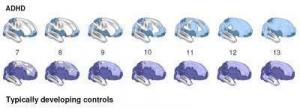
Attention-Deficit Hyperactivity Disorder (ADHD), or Hyperkinetic Disorder affects about 5% of the world’s population. It is hard to cure it and in it is currently considered to be a persistent and chronic condition and medicine does not have any cure. This is because we fail to understand it as numerous studies have shown contrary results.
What we do know are some ways that could help cure it but nothing is guaranteed. But a study from National Institutes of Health’s (NIH) National Institute of Mental Health (NIMH) has shown for a fact that in youth with attention deficit hyperactivity disorder (ADHD), the brain matures in a normal pattern but is delayed three years in some regions. This was found out with brain imaging.
“Finding a normal pattern of cortex maturation, albeit delayed, in children with ADHD should be reassuring to families and could help to explain why many youths eventually seem to grow out of the disorder,” explained Philip Shaw, M.D., NIMH Child Psychiatry Branch, who led the research team.
They were not able to find this out before because their focus was the size of the relatively large lobes of the brain. With a better image analysis technique, they were able to pinpoint the thickening and thinning of thousands of cortex sites in hundreds of children and teens, with and without the disorder.
They hope to learn about the genetic underpinnings of the delay and ways of boosting processes of recovery from the disorder. “Brain imaging is still not ready for use as a diagnostic tool in ADHD,” noted Shaw. “Although the delay in cortex development was marked, it could only be detected when a very large number of children with the disorder were included. It is not yet possible to detect such delay from the brain scans of just one individual. The diagnosis of ADHD remains clinical, based on taking a history from the child, the family, and teachers.”. So this may not be a huge leap but it is at least a place to start.


